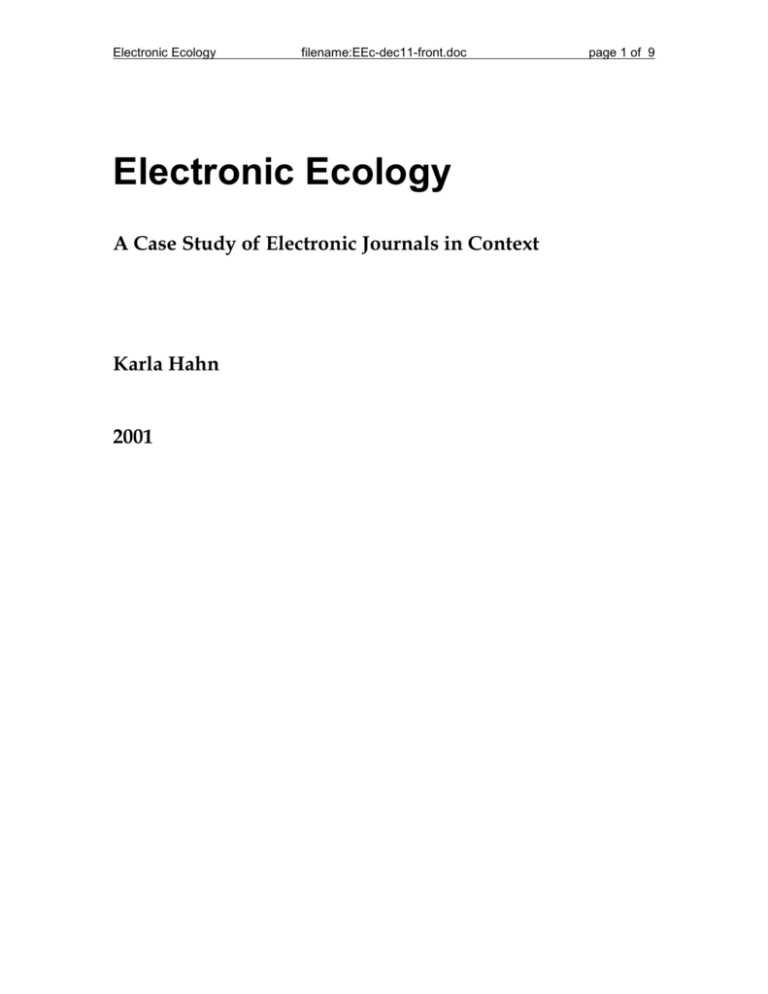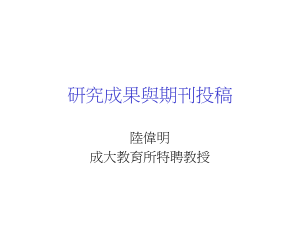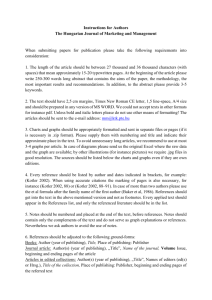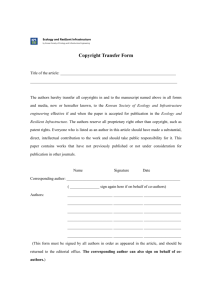Electronic Ecology - DRUM
advertisement

Electronic Ecology filename:EEc-dec11-front.doc Electronic Ecology A Case Study of Electronic Journals in Context Karla Hahn 2001 page 1 of 9 Electronic Ecology filename:EEc-dec11-front.doc page 2 of 9 Electronic Ecology A Case Study of Electronic Journals in Context Karla Hahn Association of Research Libraries 21 Dupont Circle, NW, Suite 800 Washington, DC 20036 202-296-2296 (phone) 202-872-0884 (fax) arlhq@cni.org ISBN: ………………. Copyright © 2001 This study is copyrighted by the author. Permission is granted to reproduce and distribute copies of this work for nonprofit educational or library purposes, provided that copies are distributed at or below cost, and that the author, source, and copyright notice are included on each copy. This permission is in addition to rights of reproduction granted under Sections 107, 108, and other provisions of the U.S. Copyright Act. [symbol] The paper used in this publication meets the minimum requirements of the American national Standard for Information Sciences—Permanence of Paper for Printed Library Materials, ANSI Z39.48-1984. Interior design/layout by ……… Editing by Suzanne Snell Tesh, Bethesda, MD. Electronic Ecology filename:EEc-dec11-front.doc page 3 of 9 Contents Acknowledgments Executive Summary 1: Introduction The Context: Transition from Print-based to Electronic Publishing Developing a Study of Electronic Content Scope of Study Methodology Data Collection Data Analysis Study Outcomes 2: Conceptual Frameworks Scientific Communication in the Paper World Impact of Social Factors on Scientific Communication Diffusion of Innovations Theory Ideas About Scientific communication in the Electronic World Review of E-publishing Developments in Early 1998 Measuring the Impact of Early Electronic Publishing 3: Selecting a Journal Journal Selection Decision Elements A Model of the Journal Selection System Decision-making Patterns Among Authors The Role of Social Relationships 4: The Meaning of Electronic Journals Functions of Electronic Publishing Pros, Cons, and Concerns Validity of Patterns Among Informant Groups 5: Journal System Structure: Quality, Audience, and Peer Review The Roles of Journal Identity and Peer Review A Three-tiered Model of System Structure Peer Review in Electronic Publications Alternate Models of Future Electronic Publishing 6: Integrating Function of the Publishing System Integration of Published Research Artifacts Integration of the Ecology Research Community 7: Looking Ahead Towards Electronic Publishing The Importance of Community Context Comparison of Author Selection and Journal Prestige Models Study Implications Bibliography Figure and Tables Figure 1. Model of Journal Selection Process Table 1. Number of Informants Mentioning Each Decision Element by Group Table 2. Matrix of Referent Mentions by Informants Table 3. Ecologists’ Three-tiered Model of Journal System Structure Electronic Ecology filename:EEc-dec11-front.doc page 4 of 9 Table 4. Comparison of Ecologists’ and Psychologists’ Journal System Structuring Electronic Ecology filename:EEc-dec11-front.doc Acknowledgments Karla Hahn, Ph.D. Collection Management Team Leader University of Maryland Libraries January 2001 page 5 of 9 Electronic Ecology filename:EEc-dec11-front.doc page 6 of 9 Executive Summary In the late twentieth century, the development and widespread adoption of the World-Wide Web accelerated the appearance of both new all-electronic journals and electronic counterparts of existing print journals. At the time this study was initiated in late 1997, electronic journals were still largely experimental. Little was known about their success or how they might be developed to attract both content and readership. In early 1998, the ecology community offered an opportunity that seemed in many ways an ideal natural experiment, allowing me to compare a fully electronic journal with one that was published in both print and electronic forms, both serving the same community. The ecology community was at the very earliest stages of developing a new communications system. Two new peer-reviewed journals were starting up in quite similar subject areas, one electronic only, and the other publishing print and electronic versions simultaneously, which acted in many ways as a sort of control. I chose to focus on content development—how the authors of the manuscripts and the editors who select and solicit material were viewing electronic publishing—an aspect of electronic publishing which had attracted little attention. The study’s initial structure was based on three questions: (1) What is the decision process that authors are using to decide to publish in an electronic journal? (2) How do social factors influence the author’s decision to publish in an electronic journal? (3) How do the authors and editors working closely with an electronic journal perceive electronic journals? Further structure was provided by the development of the conceptual foundations of the project, grounded in three research traditions that I found most applicable: the classic research into scientific communication, which mostly predated the widespread adoption of network technology, the sociology of science, and diffusion of innovations theory. Diffusion theory was highly influential in the formative phases of the ecology case study, including the shaping of the initial research questions and the choice of tools for conceptualizing roles and decision processes. All three traditions highlighted the importance of a community focus and provided points of comparison. Electronic Ecology filename:EEc-dec11-front.doc page 7 of 9 Electronic publishing was the up-front context for all my discussions with my informants, though print publishing practices were inevitably pervasive as contrasts to the electronic discussion. Twenty-seven informants associated with the two journals provided the main body of interviews. Editors and publishing staff from both journals were interviewed, along with a group of authors from each journal. While the consistent emphasis of the study was on authors and editors, five readers were also identified and interviewed. The research approaches I used to investigate the development of ecology’s new journals were successful, both in answering my initial research questions and by yielding emergent insights to the functions of a discipline’s journal system. The rich understanding yielded by careful study of this experiment suggests that it is not necessary to wait for circumstances favoring the creation of large quantitative data sets to begin understanding the function and implications of e-journals. Content analysis of informant interviews revealed nine common journal selection decision elements that influence an author’s decision: article quality, personal obligations, turnaround time, review process, audience size, audience character, niche, special features, and journal prestige. These elements interact in a process that authors, publishers, and editors described as attempting to match articles and journals. The data support an even richer representation of the journal selection decision, an open systems model. The model illustrates the relations between the journal selection decision’s main entities: author, editor, manuscript, and journal, and expresses a picture of the system that I found to be broadly shared within the ecology community. The model embodies the key role of editors in content recruitment and journal development, a significant study finding. The journals’ editors fit the description of opinion leaders. They are not merely central within a network of colleagues whom they canvas for manuscripts, but clearly play a powerful role in structuring the relationships of authors and readers with journals. Considering the meaning of electronic journals from the standpoint of working scientists generated a set of key functionalities that repeatedly mentioned by informants as integral to electronic publications. The first four, acceleration, usability, accessibility, and quality filtering, were often related to existing functions of the print-based journal publishing system. The second four, interaction, interconnection , online discussion, and Electronic Ecology filename:EEc-dec11-front.doc page 8 of 9 cost effectiveness, describe entirely new functions and new expectations created by the development of e-journal publishing. In the interviews from which these functionalities emerged, all groups of informants regularly described a simplified model of a structured journal system, usually possessing three tiers. Breadth of audience was described more consistently as the key variable separating tiers, as quality was recognized to vary between journals within the same tier. This important role played by breadth of audience has been widely neglected in many discussions of quality control and peer review. Looking to the future of electronic publishing, two dimensions of the publishing system that emerged from the qualitative research process strike me as particularly novel and significant for the development of an electronic publishing system: (1) the way the existing publishing system is structured by journal title identities, a process that is mediated through the peer review system. While my informants recognized that the current peer review system was time-consuming and labor intensive, the quality filtering that they rely on results directly from the review and journal systems. The emphasis the ecologists placed on the filtering role suggests that publishing system models lacking journals as organizing structures will need explicitly to substitute other features to replace this organizing function. (2) the integrating function of the publishing system as it creates and maintains connections. Electronic publishing systems were exciting to ecologists, not merely as technologies to make data accessible, but also as systems to integrate data in new ways, in order to support new ways of communicating information, such as models, across barriers of space and time. Going beyond even higherlevel improvements in electronic text linking, my informants suggested not merely integration of text, but also integration of data and other information constructs into the publishing system. This case suggests that there is room for further work in the arena of conceptualizing emerging electronic publishing systems. Even if a best design exists, it may not be adopted for cultural or other reasons. In fact, it seems likely that, given the drive for open access and integration, publishing systems serving diverse communities, while differing in significant ways, would still share many core functionalities and allow significant integration of community publishing systems. General Electronic Ecology filename:EEc-dec11-front.doc page 9 of 9 models will need to either provide enough flexibility to account for variations in communicative practice or focus on a highly abstracted level.








